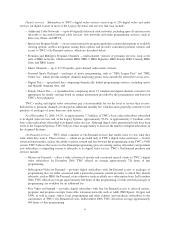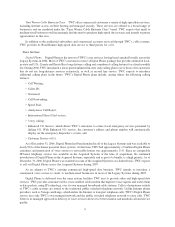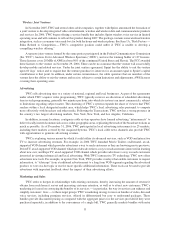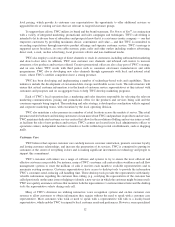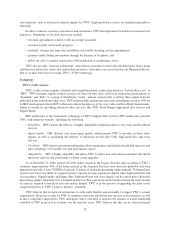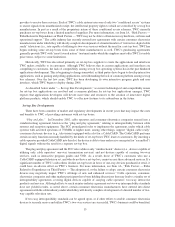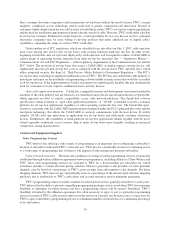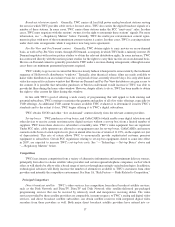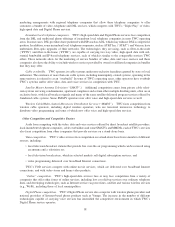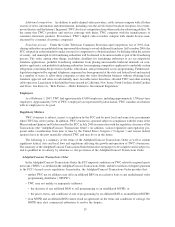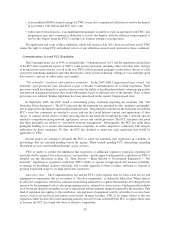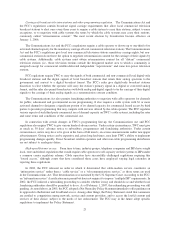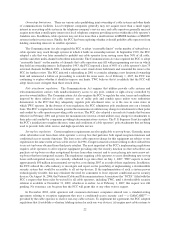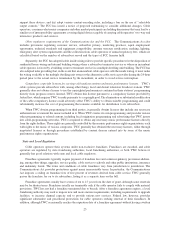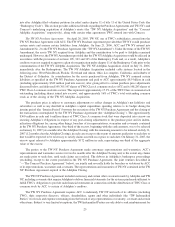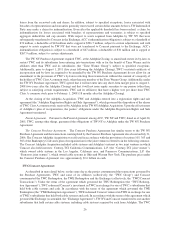Time Warner Cable 2006 Annual Report Download - page 21
Download and view the complete annual report
Please find page 21 of the 2006 Time Warner Cable annual report below. You can navigate through the pages in the report by either clicking on the pages listed below, or by using the keyword search tool below to find specific information within the annual report.First, consumer electronic companies could manufacture set-top boxes without the need to license TWC’s current
suppliers’ conditional access technology, which could lead to greater competition and innovation. Second, if
customers widely adopted such devices sold at retail, it would likely reduce TWC’s set-top box capital expenditures
and the need for installation appointments in homes already wired for cable. However, TWC could suffer a decline
in set-top box revenues. Furthermore, in the long term, as interoperability for two-way devices evolves, consumer
electronics companies may be more willing to develop products that make enhanced use of digital cable’s
capabilities, expanding the range of services TWC could offer.
Under another set of FCC regulations, which are scheduled to go into effect on July 1, 2007, cable operators
must cease placing into service new set-top boxes with security functions built into the box. In other words,
beginning on that date, new set-top boxes deployed by cable operators will be required to utilize a CableCARD or
similar means of separating security functions from other set-top box functions. See “— Regulatory Matters —
Communications Act and FCC Regulation — Other regulatory requirements of the Communications Act and the
FCC” below. The provision of set-top boxes that accept a CableCARD, or similar separate security device, will
significantly increase per-unit set-top box costs as compared with the set-top boxes TWC currently buys, which
utilize integrated security. See Item 1A, “Risk Factors—Risks Related to Government Regulation — The FCC’s
set-top box rules could impose significant additional costs on TWC.” The FCC has also ordered the cable industry to
investigate and report on the possibility of implementing a downloadable security system that would be accessible
to all set-top devices. If the implementation of such a system proves technologically feasible, this may eliminate the
need for consumers to lease separate conditional-access security devices.
Open cable application platform. CableLabs, a nonprofit research and development consortium founded by
members of the cable industry, has put forward a set of hardware and software specifications known as OpenCable,
which represent an effort to achieve compatibility across cable network interfaces. The OpenCable software
specification, which is known as “open cable application platform,” or “OCAP,” is intended to create a common
platform for set-top box applications regardless of what operating system the box uses. The OpenCable speci-
fication is consistent with the CableCARD specification promulgated under the FCC’s plug and play rules and the
encryption technology that allows the CableCARD to securely communicate with the host device. If widely
adopted, OCAP could spur innovation in applications for set-top boxes and cable-ready consumer electronics
devices. Furthermore, the availability of multi-platform set-top box applications should, together with the move
toward separable conditional access systems, help to make set-top boxes more fungible, resulting in increased
competition among manufacturers.
Content and Equipment Suppliers
Video Programming Content
TWC believes that offering a wide variety of programming is an important factor influencing a subscriber’s
decision to subscribe to and retain TWC’s video services. TWC devotes considerable resources to obtaining access
to a wide range of programming that it believes will appeal to both existing and potential subscribers.
Cable television networks. The terms and conditions of carriage of cable programming services are generally
established through written affiliation agreements between programmers, including affiliates of Time Warner, and
TWC. Most cable programming services are available to TWC for a fixed monthly per subscriber fee, which
sometimes includes a volume discount pricing structure. However, payments to the providers of some premium
channels, may be based on a percentage of TWC’s gross receipts from subscriptions to the channels. For home
shopping channels, TWC does not pay and generally receives a percentage of the amount spent on home shopping
purchases that is attributable to TWC’s subscribers and in some instances receive minimum guarantees.
TWC’s programming contracts usually continue for a fixed period of time, generally from three to seven years.
TWC believes that its ability to provide compelling programming packages is best served when TWC has maximum
flexibility to determine on which systems and tiers a programming service will be carried. Sometimes, TWC’s
flexibility is limited by the affiliation agreement. It is often necessary to agree to carry a particular programming
service in certain of TWC’s cable systems and/or carry the service on a specific tier. In some cases, it is necessary for
TWC to agree to distribute a programming service to a minimum number of subscribers or to a minimum percentage
of its subscribers.
16


